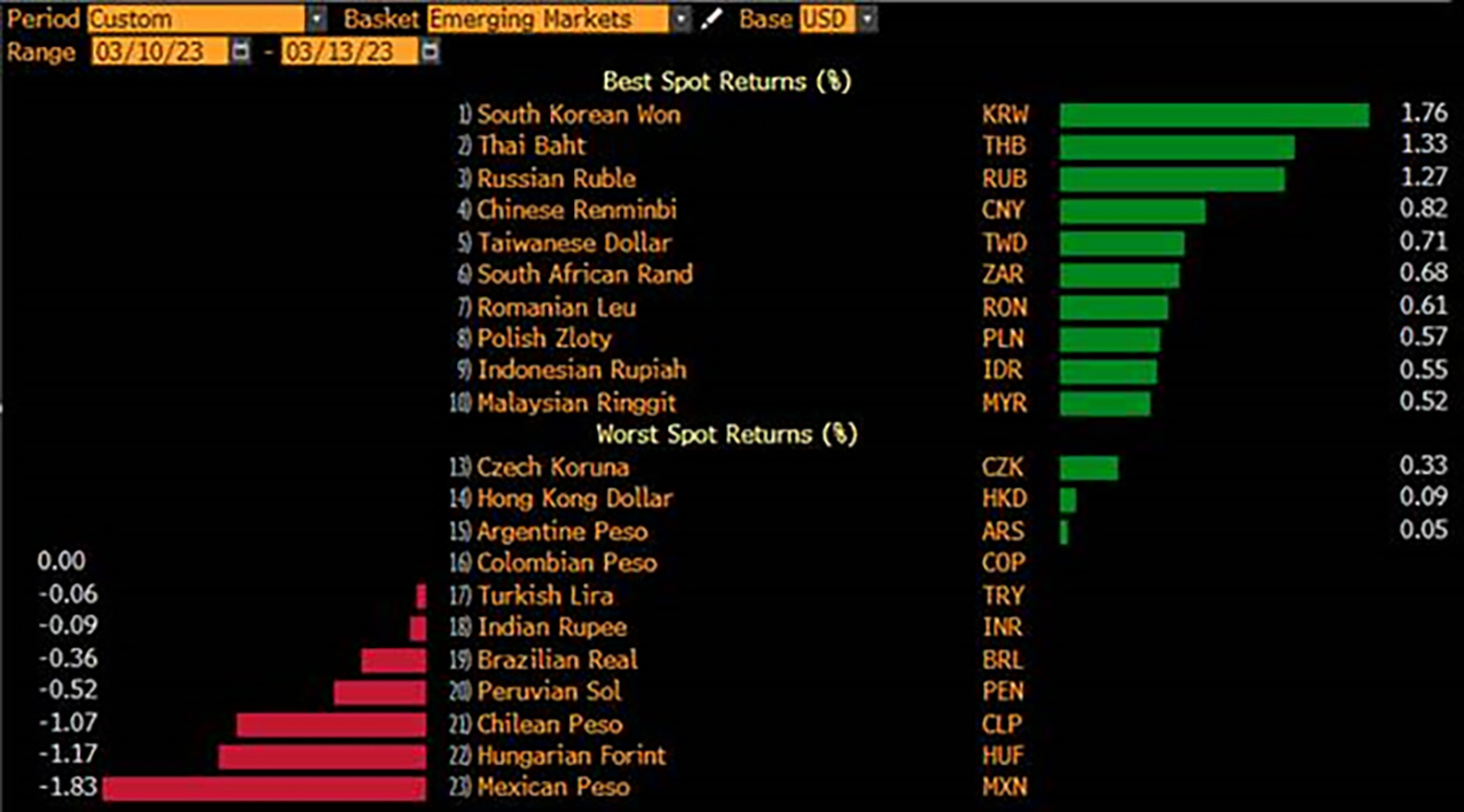U.S. Fed Boxed In… EMs Finally Free?
13 March 2023
Read Time 2 MIN
Fed Policy Rate Outlook
Bold moves from regulators might have saved the Silicon Valley Bank depositors, but the debacle caused some wild market moves, including expectations for the U.S. Federal Reserve’s (Fed’s) policy rate. Rate hikes have been almost completely priced out this morning, and the implied peak rate dropped well below 5%. The 2-year U.S. Treasury yield recorded one of the largest daily declines since 1983 – actually, the second largest at the time of the note – with many market participants questioning whether the current situation is in the same ballpark as the previous crises. On top of everything else, we have the next inflation print in the U.S. tomorrow. So, the outlook for the Fed’s next rate-setting meeting is interesting to say the least.
EMFX Performance
How are EMs doing in this environment? We are seeing a lot of red in various equity markets, but rates are rallying across the board. Many EM currencies are in the black as well (see chart below) – the Mexican peso being among few EM FX casualties so far this morning, most likely due to “nearshoring” concerns. We also noted that local swap curves continue to price in orderly and cautious rate cuts in several EMs – just as they did last week – showing no signs of panic. There are plenty of uncertainties going forward – including contagion fears – but EMs’ resilience (so far) has attracted attention.
EM Fundamental Strengths
Our long-standing arguments in favor of EM bonds are: (1) independent central banks (EM central banks moved much faster with aggressive rate hikes in the current cycle and now have very high real policy rates); (2) lower debt (hence, fewer concerns about fiscal dominance); and (3) benefits from China’s reopening (arguably, many EMs are now more correlated with China than the Fed). Many EMs learned the lessons of the past crises and strengthened their policy frameworks – both fiscal and monetary (the fact that the market would regularly punish them for policy transgressions definitely helped). It is easy to ignore these factors during “everything rallies” – but will this be the moment when EMs will finally come of age? Stay tuned!
Chart at a Glance: EM FX – Holding on Well, Despite Market Turbulence

Source: Bloomberg LP
Related Insights
IMPORTANT DEFINITIONS & DISCLOSURES
This material may only be used outside of the United States.
This is not an offer to buy or sell, or a recommendation of any offer to buy or sell any of the securities mentioned herein. Fund holdings will vary. For a complete list of holdings in VanEck Mutual Funds and VanEck ETFs, please visit our website at www.vaneck.com.
The information presented does not involve the rendering of personalized investment, financial, legal, or tax advice. Certain statements contained herein may constitute projections, forecasts and other forward looking statements, which do not reflect actual results. Information provided by third-party sources are believed to be reliable and have not been independently verified for accuracy or completeness and cannot be guaranteed. Any opinions, projections, forecasts, and forward-looking statements presented herein are valid as of the date of this communication and are subject to change without notice. The information herein represents the opinion of the author(s), but not necessarily those of VanEck.
The views contained herein are not to be taken as advice or a recommendation to buy or sell any investment in any jurisdiction, nor is it a commitment from Van Eck Associates Corporation or its subsidiaries to participate in any transactions in any companies mentioned herein. This content is published in the United States. Investors are subject to securities and tax regulations within their applicable jurisdictions that are not addressed herein.
All investing is subject to risk, including the possible loss of the money you invest. As with any investment strategy, there is no guarantee that investment objectives will be met and investors may lose money. Diversification does not ensure a profit or protect against a loss in a declining market. Past performance is no guarantee of future results.
